AREA OF A TRAINGLE
Area of parallelograms of Class 9
POLYGONAL REGION
Polygon region can be expressed as the union of a finite number of triangular regions in a plane such that if two of these intersect, their intersection is either a point or a line segment. It is the shaded portion including its sides as shown in the figure.
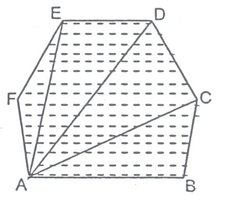
Area Axioms:
Every polygonal region R has an area, measure in square unit and denoted by ar(R).
- Congruent area axiom : if R1 and R2 be two regions such that R1≅R2 then ar(R1) = ar (R2).
-
Area monotone axiom :If R1
 R2, then are (R1)
R2, then are (R1)  ar(R2).
ar(R2). -
Area addition axiom : If R1 are two polygonal regions, whose intersection is a finite number of points and line segments and R = R1
 R2, then ar (R) = ar(R1) + ar(R2).
R2, then ar (R) = ar(R1) + ar(R2). - (iv) Rectangular area axiom :If AB = a metre and AD = b metre then,
ar (Rectangular region ABCD) = ab sq. m.
Unit of Area :
There is a standard square region of side 1 metre, called a square metre, which is the unit of area measure. The area of a polygonal region is square metres (sq. m or m2) is a positive real number
AREA ADDITION AXIOM:
Total area R of the plane figure ABCD is the sum of two polygonal regions R1 and R2, i.e. ar. (R) = ar. (R1) +ar . (R2)
THEOREM – 1:
A diagonal of parallelogram divides it into two triangles of equal area.
Given: A parallelogram ABCD whose one of the diagonals is BD.
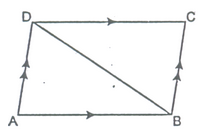
To prove: ar (ΔABD) = ar (ΔCDB).
Proof: In ΔABD and ΔCDB.
AB = DC [Opp. sides of a ||gm]
AD = BC [Opp. sides of a ||gm]
BD = BD [Common side]
∴ ΔABD≅ΔCDB [By SSS]
∴ ar (ΔABD) = ar(ΔCDB) [Congruent area axiom] Hence Proved.
THEOREM – 2:
Prove that parallelogram on the same base and between same parallel are equal in area.
Given: Parallelogram ABCD and ABEF are on the same base AB and between the same parallels AB and CF.
To Prove: ar. (ABCD) = ar. (ABEF)
Proof: In ΔADF and ΔBCE, we have
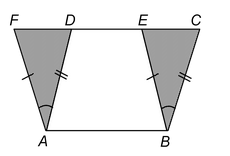
AF = BE [Opposite sides of the ||gms]
∠AFD = ∠BEC [Corresponding angles]
∠ADF = ∠BCE [Corresponding angles]
∴ ΔADF≅ΔBCE [By AAS Congruence]
⇒ ar. (ΔADF) = ar. (ΔBCE) [Congruence area axiom]
Adding ar.(quadrilateral ABED) to both sides, we get
ar. (ΔADF) + ar.(quadrilateral ABED) = ar (ΔBCE) + ar.(quadrilateral ABED)
⇒ ar. ||gmABEF = ar. ||gmABCD [Area addition axiom]
THEOREM – 3:
Prove that parallelogram and a rectangle on the same base and between the same parallels are equal in area.
Given :A Parallelogram ABCD and a rectangle ABML are on the same base AB and between the same parallels AB and CL.
To Prove : ar. ||gmABCD = ar. rectangle ABML.
Proof :In ΔADL and ΔBCM, we have
AL = BM [Opposite sides of a rectangle]
∠ALD = ∠BMC[Corresponding angles]
∠ADL = ∠BCM [Corresponding angles]
∴ ΔADL≅ΔBCM [By AAS congruence]
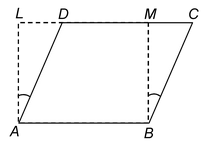
⇒ ar. (ΔADL) = ar. (ΔBCM)
Adding ar. (quadrilateral ABMD) to both sides, we get
ar. ΔADL + ar. quadrilateral ABMD = ar. ΔBCM + ar. quadrilateral ABMD
or ar. of rectangle ABML = ar. of ||gmABCD.
THEOREM – 4:
If a triangle and a parallelogram are on the same base and between the same parallels, then prove that the area of the triangle is equal to half the area of the parallelogram.

(i) (ii)
Given: AParallelogram ABCD and a triangle APB are on the same base AB and between the same parallels AB and PC.
To Prove: ar. 
Const: Through B draw BQ || AP which meets PC or PC produced at Q. Join BQ
Proof: Since the parallelogram ABQP and the parallelogram ABCD stand on the same base AB and between same parallels AB and PQ or DQ.
∴ ar. ||gmABQP = ar. ||gmABCD [By theorem 1] …(i)
Since the diagonal of a ||gmABQP divides it into two Δs of equal area
∴ ar. ||gmABQP = 2 ar. (ΔPAB) …(ii)
From (i) and (ii), we have
2 ar. (ΔPAB) = ar. ||gmABCD
⇒ ar. .
.
THEOREM – 5:
The arc of parallelogram is the product of its base and the corresponding altitude.
Given: A||gm ABCD in which AB is the base and AL is the corresponding height.
To prove: Area (||gmABCD) = AB × AL.
Construction: Draw BM  DC so that rectangle ABML is formed.
DC so that rectangle ABML is formed.
Proof: ||gm ABCD and rectangle ABML are on the same base AB and between the same parallel lines AB and LC.
∴ ar(||gmABCD) = ar(rectangle ABML) = AB × AL.
∴ area of a ||gm = base × height.
Ex: Prove that a diagonal of a parallelogram divides it into two triangles of equal area.
Solution: Given: A parallelogram ABCD in which BD is one of the diagonals.
To prove →ar(ΔABD) = ar(ΔCDB)
Proof:
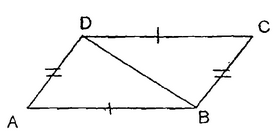
In triangles ABD and CDB, we have
AB = CD (in a parallelogram opposite sides are of equal length)
AD = CB
and BD = DB (common side)
⇒ ABD ≅ ΔCDB (by SSS)
ABD ≅ ΔCDB (by SSS)
Hence by congruent area axiom ar(ΔABD) = ar(ΔCDB).
Ex. A parallelogram ABCD and a rectangle ABPQ are on the same base AB and between the same parallels AB and CQ. If AB = 8 cm and AQ = 6 cm, find the area of ||gmABCD.
Sol. A rectangle is a parallelogram in which each angle is 90° and parallelogram on the same base and between same parallels are equal in area.

∴ ar. (||gmABCD) = ar. (rectangle ABPQ)
But ar. (||gmABPQ) = AB×AQ
= (8 × 6) cm2 = 48 cm2
∴ Area of parallelogram ABCD = 48 cm2.
Ex. In a parallelogram ABCD, AB = 8 cm. The altitudes corresponding to sides AB and AD are respectively 4 m and 5 cm. Find AD.
Sol. We know that, Area of a parallelogram = Base × Corresponding altitude
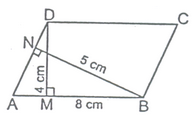
∴ Area of parallelogram ABCD = AD × BN = AB × DM
⇒ AD × 5 = 8 × 4
⇒ AD = 
= 6.4 cm. Ans.
Ex. In figure, ABCD is a parallelogram, AE⊥CD and CF⊥AD. If AB = 16 cm, AE = 8 cm and CF = 10 cm, find AD.
Sol. AB = 16 cm, AE = 8 cm and CF = 10 cm, AD= ?
ar. ||gmABCD (on base AD) = ar. ||gmABCD (on base CD)

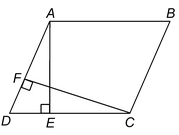
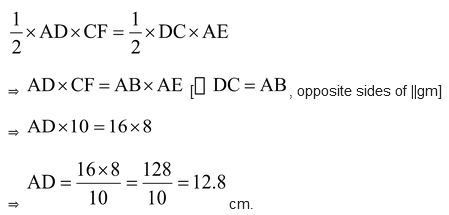
Ex: ABCD is a quadrilateral and BD is one its diagonals as shown in figure. Show that ABCD is a parallelogram and find its area.
Sol: In ΔABD and ΔCDB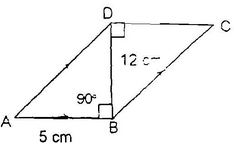
∠ABD = ∠CBD = 90o (alternate interior angles are equal)
∠ADB = ∠CBD
∠BDA = ∠BDC
Hence, ABCD is a parallelogram.
Now, area of parallelogram ABCD = (base ×corresponding altitude)
⇒area of parallelogram ABCD = AB × BD = 5 ×12 sq. units = 60 sq. cms.
Ex: Prove that parallelograms on the same base and between the same parallel lines are equal in area.
Sol: Given: Two parallelogram ABCD and PBCQ having same base BC and between the same parallel lines BC and AQ.
To Prove: ar(parallelogram ABCD)= ar (parallelogram PBCQ)
Proof: In triangles ABP and DCQ,
BAP = ∠CDQ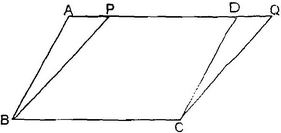
(Corresponding angles when AQ intersects parallel lines AB and DC).
∠BPA = ∠CDQ
(Corresponding angles when AQ intersects parallel lines BP and CQ).
AB = DC (Opposite sides of a parallelogram)
∴ΔABP ≅ ΔDCQ (AAS)
Hence area ΔABP = area ΔDCQ
or, area ΔABP + area BPDC = area ΔDCQ + area BPDC
∴ar (parallelogram ABCD) = ar (parallelogram PBCQ).
Ex. In figure, ABCD is a parallelogram, AE  DC and CF
DC and CF AD. If AB = 16 cm, AE = 8 cm and CF = 10 cm find AD.
AD. If AB = 16 cm, AE = 8 cm and CF = 10 cm find AD.

Sol. We have AB = 16 cm, AE = 8 cm CF = 10 cm.
We know that are of parallelogram = Base × Height [Base = CD, height = AE]
ABCD = CD × AE = 16 × 8 = 128 cm2
Again, Area of parallelogram = Base × Height = AD × CF [Base = AD, height = CF]
128 = AD × 10
⇒ AD = 128/10=12.8 cm Ans.
Ex: In figure, ABCD is a parallelogram and EFCD is a rectangle. Also AL  DC
DC
and AL = DE . Prove that ar(ABCD) = ar(EFCD)
Sol: Rectangle is also a parallelogram.
Thus, parallelogram ABCD and rectangle EFCD are on the same base CD.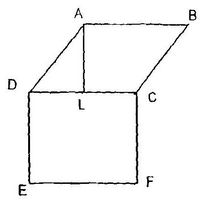
Thus ar(||gm ABCD) = DC X AL
Ar(DEFC) = DC X DE
= DC X AL
= ar(||gm ABCD).
Ex: Parallelogram ABCD and rectangle ABEF have the same base AB and also have equal areas. Show that the perimeter of the parallelogram is greater than that of the rectangle.
Sol: To prove:Perimeter of parallelogram ABCD > perimeter of

rectangle ABEF i.e.
AB + BC + CD + AD > AB + BE + EF + AF
Since opposite sides of a parallelogram and a rectangle are equal.
∴ AB = DC = EF … (i) (Since ABCD is a parallelogram)
∴ AB + DC = AB + EF … (ii)
Since, of all the segments that can be drawn to a given line form a point not lying on it, the perpendicular segment is the shortest.
∴ BE < BC and AF < AD
⇒ BC + AD > BE + AF … (iii)
Adding (ii) and (iii), we get
AB + DC + BC + AD > AB + EF + BE + AF
∴ AB + BC + CD + DA > AB + BE + EF + FA.
AREA OF A TRAINGLE
Theorem – 5:
Two triangles on the same base (or equal bases) and between the same parallels are equal in area.
Given: Two triangles ABC and PCs on the same base BC and between the same parallel lines BC and AP.
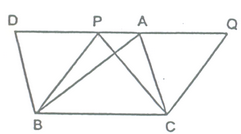
To prove: ar(ΔABC) = ar(ΔPBC)
Construction: Through B, draw BD || CA intersecting PA produced in D and through C, draw CQ || BP, intersecting line AP in Q.
Proof :We have,
BD || CA [By construction]
And,BC || DA [Given]
 Quad. BCAD is a parallelogram.
Quad. BCAD is a parallelogram.
Similarly, Quad. BCQP is a parallelogram.
Now, parallelogram BCQP and BCAD are on the same base BC, and between the same parallels.
 ar(||gm BCQP) = ar(||gmBCAD) ....(i)
ar(||gm BCQP) = ar(||gmBCAD) ....(i)
We know that the diagonals of a parallelogram divides it into two triangles of equal area.
 ar(ΔPBC=
ar(ΔPBC= (||gm BCQP) ....(ii)
(||gm BCQP) ....(ii)
And ar(ΔABC) =  ar(||gm BCAD) ....(iii)
ar(||gm BCAD) ....(iii)
Now, ar(||gm BCQP) = ar(||gm BCAD) [From (i)]
⇒  ar(||gm BCAD) =
ar(||gm BCAD) =  ar(||gm BCQP)
ar(||gm BCQP)
Hence, ar(ΔABC) = ar(ΔPBC) [Using (ii) and (iii)]
Hence Proved.
THEOREM – 6:
The area of a trapezium is half the product of its height and the sum of the parallel sides.

Given: Trapezium ABCD in which AB || DC, AL DC, CN
DC, CN AB and AL = CN = h (say)
AB and AL = CN = h (say)
AB = a, DC = b.
To prove: ar(trap. ABCD) =  h × (a + b).
h × (a + b).
Construction: Join AC.
Proof: AC is a diagonal of quad. ABCD.
∴ ar(trap. ABCD) = ar(ΔABC) + ar(ΔACD) =  h × a +
h × a + h × b=
h × b= h(a + b). Hence Proved.
h(a + b). Hence Proved.
THEOREM – 7:
Triangles having equal areas and having one side of the triangle equal to corresponding side of the other, have their corresponding altitudes equal/
Given: Two triangles ABC and PQR such that (i) ar (ΔABC) = ar(ΔPQR) and (ii) AB = PQ.
CN and RT and the altitude corresponding to AB and PQ respectively of the two triangles.
To prove :CR = RT.
Proof :In ΔABC, CN is the altitude corresponding to the side AB.
ar(ΔABC) =  AB × CN ....(i)
AB × CN ....(i)
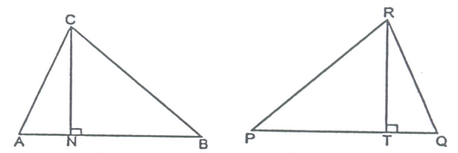
Similarly, ar(ΔPQR) =  PQ × RT ....(ii)
PQ × RT ....(ii)
Since ar(ΔABC) =ar(ΔPQR) [Given]
∴  AB × CN =
AB × CN =  PQ × RT
PQ × RT
Also, AB = PQ [Given]
CN = RT Hence Proved.
Ex: Prove that the area of a triangle is half the product of any of its side and the corresponding altitude.
Sol: Given: A ABC in which AL is the altitude to the side BC.
ABC in which AL is the altitude to the side BC.
To prove: ar(ΔABC) =  (BC
(BC  AL)
AL)
Construction: Through C and A draw CD || BA and AD || BC respectively intersecting each other at D
Proof: We have BA || CD (by construction)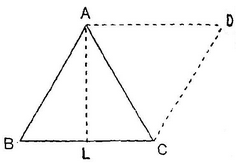
and AD || BC (by construction)
∴ BCDA is a parallelogram.
Since AC is a diagonal of ||gm BCDA. Therefore,
ar(ΔABC) =  ar (||gm BCDA)
ar (||gm BCDA)
⇒ar(ΔABC) =  (BC
(BC  AL) ( BC is the base and AL is the corresponding altitude of ||gm BCDA)
AL) ( BC is the base and AL is the corresponding altitude of ||gm BCDA)
Ex: AD is one of the medians of aΔ ABC. X is any point on AD. Show that
ar(Δ ABX) = ar(Δ ACX)
Sol: In ΔABC, AD is a median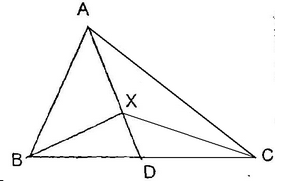
∴ar(ΔABD) = ar(ΔACD) … (1)
(median divides a Δ into two Δ’s of equal area)
again, in ΔXBC, XD is median
∴ar(ΔXBD) = ar(ΔXCD) … (2)
Subtracting (2) from (1), we get
ar(ΔABD) – ar(ΔXBD)
= ar(ΔACD) – ar(ΔXCD)
⇒ar(ΔABX) = ar(ΔACX).
Ex. Triangles ABC and DBC are on the same base BC; with A, D on opposite sides of the line BC, such that ar(ΔABC) = ar(ΔDBC). Show that BC bisects AD.
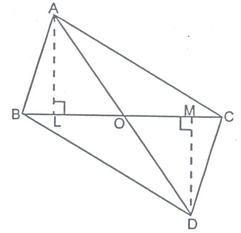
Sol. Construction :Draw AL  BC and DM
BC and DM  BC.
BC.
Proof :ar(ΔABC) = ar(ΔDBC) [Given]
⇒ 
⇒ AL = DM ....(i)
Now in Δs OAL and OMD
AL = DM [From (i)]
⇒ ∠ALO = ∠DMO [Each = 90o]
⇒ ∠AOL = ∠MOD [Vert. opp. ∠s]
⇒ ∠OAL = ∠ODM [Third angles of the triangles]
 ΔOAL
ΔOAL ΔOMD [By ASA]
ΔOMD [By ASA]
 OA = OD [By cpctc]
OA = OD [By cpctc]
i.e., BC bisects AD. Hence Proved.
Ex: The diagonals of quadrilateral ABCD, AC and BD intersect in O. Prove that if BO = OD, the triangles ABC and ADC are equal in area.
Sol:Given: A quadrilateral ABCD in which its diagonals AC & BD intersect at O such that BO = OD.
To Prove: ar(ΔABC) = ar(ΔADC)
Proof: In ΔABD, we have BO = OD (Given)
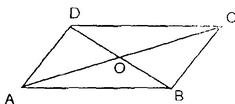
⇒ O is mid-point of BD
⇒ AO is the median
⇒ar (ΔAOB) = ar(ΔAOD) … (1)
(∴median divides a Δ into two Δ’s of equal area)
In ΔCBD, O is the mid-point of BD ⇒ CO is median
⇒ar(ΔCOB) = ar(ΔCOD) … (2)
Adding (1) and (2), we get
ar(ΔAOB) + ar(ΔCOB) = ar(AOD) + ar(ΔCOD)
⇒ar(ΔABC) = ar(ΔADC)
Ex: Triangles ABC and DBC are on the same base BC with A, D on opposite side of line BC, such that ar(ΔABC) = ar(ΔDBC). Show that BC bisects AD.
Sol:Since Δ’s ABC and DBC are equal in area and have a common base BC. Therefore the altitudes corresponding to BC are equal i.e. AE = DF
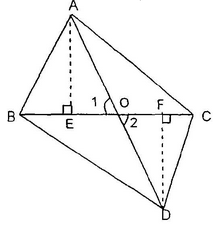
Now in Δ’s AEO and DFO, we have
∠1 = ∠2 (vertically opposite angles)
∠AEO = ∠DFO (each equal to 90o)
and AE = DF
so, by ASA criterion of congruence,
ΔAEO ≅ ΔDFO
⇒ AO = DO ⇒ BC bisects AD.
Ex:In figure, D, E are points on sides AB & AC respectively of ΔABC, such that ar(ΔBCE) = ar(ΔBCD). Show that DE || BC.
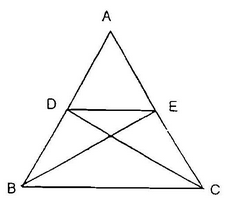
Sol: Since Δs BCE and ΔBCD are equal in area and have a same base BC. Therefore altitude from E of
ΔBCE = Altitude from D of ΔBCD ⇒Δs BCE and BCD are between the same parallel lines.
⇒ DE || BC.
Ex: If the medians of ΔABC interests at G, show that
ar(ΔAGB) = ar(ΔAGC) = ar(ΔBGC) = 1/3 ar (ΔABC).
Sol: Given: A ABC such that its medians AD, BE & CF interest at G.
ABC such that its medians AD, BE & CF interest at G.
To prove: ar(ΔAGB) = ar(ΔAGC)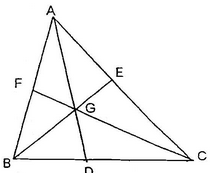
= ar(ΔBGC) = 1/3ar(ΔABC).
Proof: We know that medians of a triangle divides it into two triangles of equal area.
In ΔABC, AD is the median
⇒ar(ΔABD) = ar(ΔACD) … (1)
In  GBC, GD is the median
GBC, GD is the median
⇒ar(ΔGBD) = ar(ΔGCD) … (2)
Subtracting (2) from (1), we get
ar(ΔABD) – ar(ΔGBD) = ar(ΔACD) – ar(ΔGCD)
⇒ar(ΔAGB) = ar(ΔAGC) … (3)
Similarly, ar(ΔAGB) = ar(ΔGBC) … (4)
from (3) and (4) we get ar(ΔAGB) = ar(AGC) = ar(ΔBGC)
but ar(ΔAGB) + ar(ΔAGC) + ar(ΔBGC) = ar(ΔABC)
∴ 3 ar(ΔAGB) = ar(ΔABC) ⇒ ar(ΔAGB) = 1/3ar(ΔABC)
Hence ar(ΔAGB) = ar(ΔAGC) = ar(ΔBCG) = 1/3 ar (ΔABC).
Ex: ABC is a triangle in which D is the mid-point of BC and E is the mid-point of AD. Prove that area (ΔBED) = 1/4 are (ΔABC).
Sol: Since AD is the median of ΔABC and median divides a triangle into two triangles of equal areas.
∴area (ΔABD) = area (ΔADC)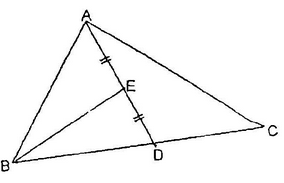
⇒area (ΔABD) =  area (ΔABC) … (i)
area (ΔABC) … (i)
In ΔABD, BE is the median
∴area (ΔBED) = area (ΔBAE) … (ii)
⇒area (ΔBED) =  area (ΔABD)
area (ΔABD)
⇒area (ΔBED) =  ×
×  area (ΔABC) [from (i)]
area (ΔABC) [from (i)]
= 1/4area (ΔABC).









